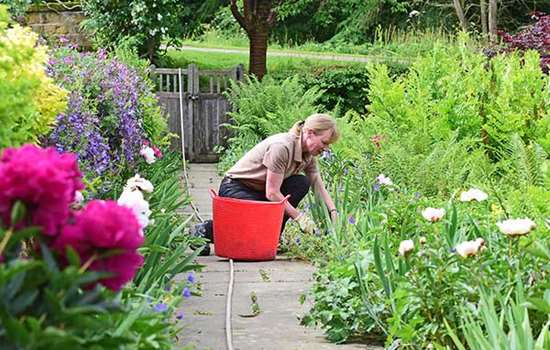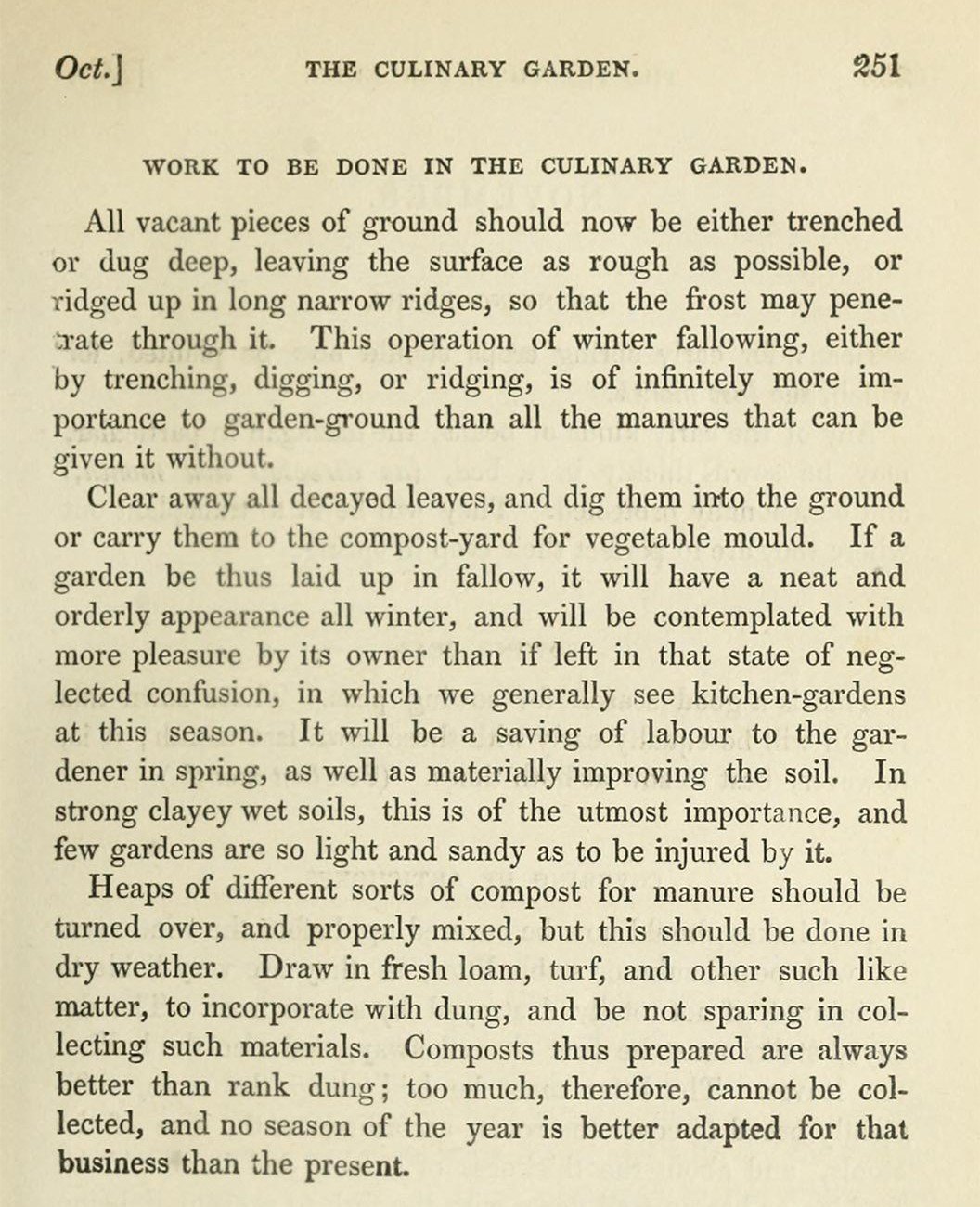Tools and Repairs
Before the invention of plastic, the tools and equipment used in gardens were intended to be reused many times. Until the mid 20th century all plant pots were made from terracotta or wood, and plant labels were usually made of wood or metal. By the end of the 19th century you could buy zinc labels pre-stamped with plant names. On large country house estates, each gardener usually had his own set of tools which he would have to clean and maintain at the end of each day, often kept in a dedicated tool room. An 18th-century gardener’s contract from Marble Hill, in London, required that ‘all tools … shall be constantly kept & repair’d by him’.
If tools became worn or damaged beyond repair the head gardener would have to ask the owner or estate manager for permission and money to replace them. In 1818 at Audley End, Essex, the blacksmith, Richard Spicer, billed the land agent 6d. to repair a spade by replacing a rivet in the handle.
Today, reusing pots and labels made of sustainable materials, and repairing tools and equipment rather than replacing them, are all ways we can aim to garden more sustainably.
Composts and Fertilisers
In the 19th century compost was usually homemade from many different components, including decayed leaves, dung, loam, sand, charcoal, gravel and bones. Gardeners were often secretive about their exact recipe.
Recipes for fertilisers have evolved over the centuries. In the late 16th and early 17th centuries garden writers would recommend adding dung and pigeon droppings to water to create a fertiliser. In the early 19th century fertilisers became increasingly complex and included a wide range of products such as bone meal and guano (bird droppings). By the late 19th century inorganic ingredients were also being included, such as gypsum sulphate, magnesium limestone and nitric acid. At Down House, in Kent, Charles Darwin had a septic tank system for horse excrement, which he filtered through a series of tanks, leaving dry manure at one end and liquid fertiliser at the other.
Using homemade composts can reduce the need for fertilisers and pesticides, which decreases the amount of chemicals added to the soil. It also means less industrial processing and less plastic and reduces the carbon footprint of buying compost.
Pests and Diseases
Historically, poisons and chemicals, such as arsenic, mercury and strychnine, were used to control pests and diseases. Most are no longer in use because of their detrimental effect on the environment and human health. However, other more environmentally friendly methods of pest and disease control were also used in the past, and we can learn from these today. This includes mechanical methods (such as nets and traps) and frequent inspections of plants.
John Evelyn’s reference to a ‘net to preserve seedes from Birds’ in 1686 is one of the earliest references to using nets to protect plants in English gardens, although it was probably a much older custom. From the 18th century onwards pests were also eradicated by syringing infested leaves with water. Women and garden boys were employed to get rid of butterfly eggs and caterpillars by hand, and the garden boy was often also responsible for scaring birds and picking slugs. In March 1874 a gardener at Audley End recorded covering cauliflower with ‘netting to protect from birds’ and in June the same year a ‘boy came in garden for frightening bird from fruit’.
Garden Design and Planting Techniques
Today, food from warmer climates is readily available all year round, but historically country estates needed to grow their own produce throughout the year. Kitchen gardens were specifically designed to take advantage of (as well as protect from) the changing seasons. The orientation of the walls created different areas of heat and shade in the borders below them in order to bring forward (force) crops or delay them. For example, the ripening of cherries, plums and gooseberries could be delayed by planting them on the north side of the wall. In 1797 a gardener at Audley End recorded sowing ‘Cress seed on a warm border for winter Saleting [salad]’.
Today, using thoughtful and clever garden design, alongside growing our own fruit and vegetables, can help mitigate the effects of climate change and reduce our carbon footprint.
Seeds and Storage
In the 19th century advances in selective breeding meant that gardeners could produce varieties that flowered and fruited earlier or later in the season. For example, at Kenwood in 1819 they purchased seeds for ‘early’ purple broccoli and ‘late’ purple broccoli. The previous year’s seeds were also stored in seed cabinets or dedicated seed rooms.
As well as storing seeds, it was important for houses to be able to store their homegrown fruit and vegetables for the winter months. Before the late 18th century, rooms over stables, sheds and lofts were used for storage. After that, on larger estates, custom built storerooms were created, often in the sheds behind the kitchen garden. Potatoes, carrots and other root vegetables were stored in cellars divided into stalls (like wine cellars) and kept in casks or jars, or left in heaps of sand and covered with straw to retain moisture.
Specialised fruit rooms were built to store the eating apples and pears on racks of shelves, as well as pineapples, melons and peaches. Cooking apples and pears were kept in heaps under the shelves or stored in the cellar. Some vegetables (such as onions, gourds and cabbages) kept better in light and airy lofts. Belsay Hall in Northumberland and Osborne on the Isle of Wight both had dedicated storerooms for fruit.
Water Management
Maintaining a constant supply of water was key to the management of gardens, especially on large estates. Dipping ponds (shallow pools) were used in kitchen gardens to provide easy access to water and their use may go back to the medieval period. There were two in the kitchen garden at Audley End in the 19th century.
Gardens also used wells, pumps and pipes to move water around and by the 19th century leather hoses with brass nozzles were used for watering. Rainwater was often collected from roofs throughout the estate and collected in tanks to be used in the garden. At Osborne tanks were located under the two main greenhouses.
Tanks and purpose-built reservoirs could also provide water for fountains. At Witley Court, in Worcestershire, the Perseus and Andromeda fountain needed water to be pumped from a nearby pool to a reservoir more than half a mile away and 30 metres above the level of the house.
Using historic storage systems (such as dipping ponds and rainwater tanks) and finding new ways to store water can help make us less dependent on mains water and more resilience to periods of drought.
By Emily Parker
Explore More
-

Caring for our Wildlife
We look at some of the ways we can conserve nature at our heritage sites – increasing biodiversity, protecting rare species and their habitats, and reintroducing wildlife that has historic connections to our sites.
-

Sustainability
With nature in decline and the impact of the changing climate becoming clear, find out how we’re reducing our environmental impact and making space for nature.
-

Conservation of our Gardens
Learn about some of the different aspects of our gardens conservation work and explore our most recent and ongoing projects.

